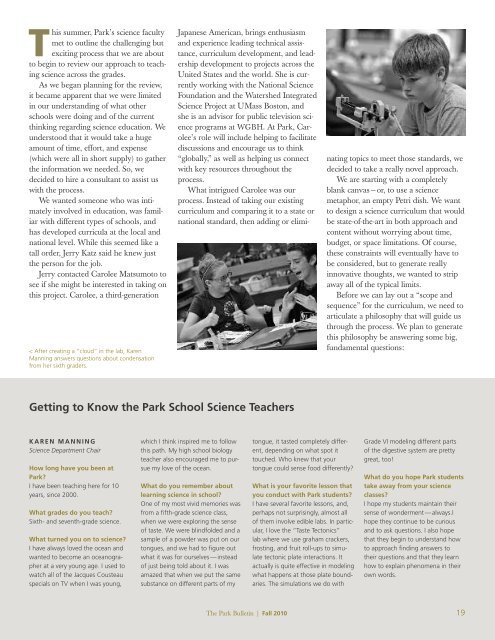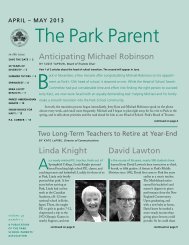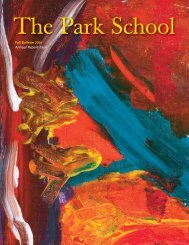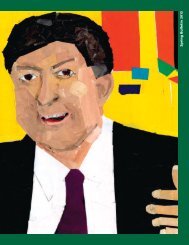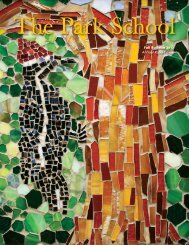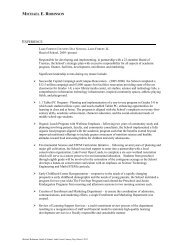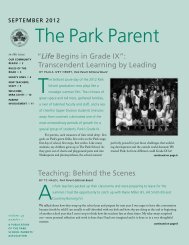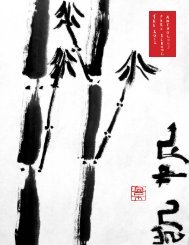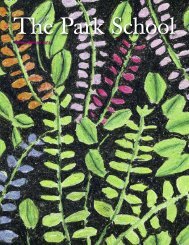⢠ParkBulletinCover - The Park School
⢠ParkBulletinCover - The Park School
⢠ParkBulletinCover - The Park School
- No tags were found...
Create successful ePaper yourself
Turn your PDF publications into a flip-book with our unique Google optimized e-Paper software.
This summer, <strong>Park</strong>’s science facultymet to outline the challenging butexciting process that we are aboutto begin to review our approach to teachingscience across the grades.As we began planning for the review,it became apparent that we were limitedin our understanding of what otherschools were doing and of the currentthinking regarding science education. Weunderstood that it would take a hugeamount of time, effort, and expense(which were all in short supply) to gatherthe information we needed. So, wedecided to hire a consultant to assist uswith the process.We wanted someone who was intimatelyinvolved in education, was familiarwith different types of schools, andhas developed curricula at the local andnational level. While this seemed like atall order, Jerry Katz said he knew justthe person for the job.Jerry contacted Carolee Matsumoto tosee if she might be interested in taking onthis project. Carolee, a third-generation< After creating a “cloud” in the lab, KarenManning answers questions about condensationfrom her sixth graders.Japanese American, brings enthusiasmand experience leading technical assistance,curriculum development, and leadershipdevelopment to projects across theUnited States and the world. She is currentlyworking with the National ScienceFoundation and the Watershed IntegratedScience Project at UMass Boston, andshe is an advisor for public television scienceprograms at WGBH. At <strong>Park</strong>, Carolee’srole will include helping to facilitatediscussions and encourage us to think“globally,” as well as helping us connectwith key resources throughout theprocess.What intrigued Carolee was ourprocess. Instead of taking our existingcurriculum and comparing it to a state ornational standard, then adding or eliminatingtopics to meet those standards, wedecided to take a really novel approach.We are starting with a completelyblank canvas —or, to use a sciencemetaphor, an empty Petri dish. We wantto design a science curriculum that wouldbe state-of-the-art in both approach andcontent without worrying about time,budget, or space limitations. Of course,these constraints will eventually have tobe considered, but to generate reallyinnovative thoughts, we wanted to stripaway all of the typical limits.Before we can lay out a “scope andsequence” for the curriculum, we need toarticulate a philosophy that will guide usthrough the process. We plan to generatethis philosophy be answering some big,fundamental questions:Getting to Know the <strong>Park</strong> <strong>School</strong> Science TeachersK A R E N M A N N I N GScience Department ChairHow long have you been at<strong>Park</strong>?I have been teaching here for 10years, since 2000.What grades do you teach?Sixth- and seventh-grade science.What turned you on to science?I have always loved the ocean andwanted to become an oceanographerat a very young age. I used towatch all of the Jacques Cousteauspecials on TV when I was young,which I think inspired me to followthis path. My high school biologyteacher also encouraged me to pursuemy love of the ocean.What do you remember aboutlearning science in school?One of my most vivid memories wasfrom a fifth-grade science class,when we were exploring the senseof taste. We were blindfolded and asample of a powder was put on ourtongues, and we had to figure outwhat it was for ourselves —insteadof just being told about it. I wasamazed that when we put the samesubstance on different parts of mytongue, it tasted completely different,depending on what spot ittouched. Who knew that yourtongue could sense food differently?What is your favorite lesson thatyou conduct with <strong>Park</strong> students?I have several favorite lessons, and,perhaps not surprisingly, almost allof them involve edible labs. In particular,I love the “Taste Tectonics”lab where we use graham crackers,frosting, and fruit roll-ups to simulatetectonic plate interactions. Itactually is quite effective in modelingwhat happens at those plate boundaries.<strong>The</strong> simulations we do withGrade VI modeling different partsof the digestive system are prettygreat, too!What do you hope <strong>Park</strong> studentstake away from your scienceclasses?I hope my students maintain theirsense of wonderment—always.Ihope they continue to be curiousand to ask questions. I also hopethat they begin to understand howto approach finding answers totheir questions and that they learnhow to explain phenomena in theirown words.<strong>The</strong> <strong>Park</strong> Bulletin | Fall 2010 19


